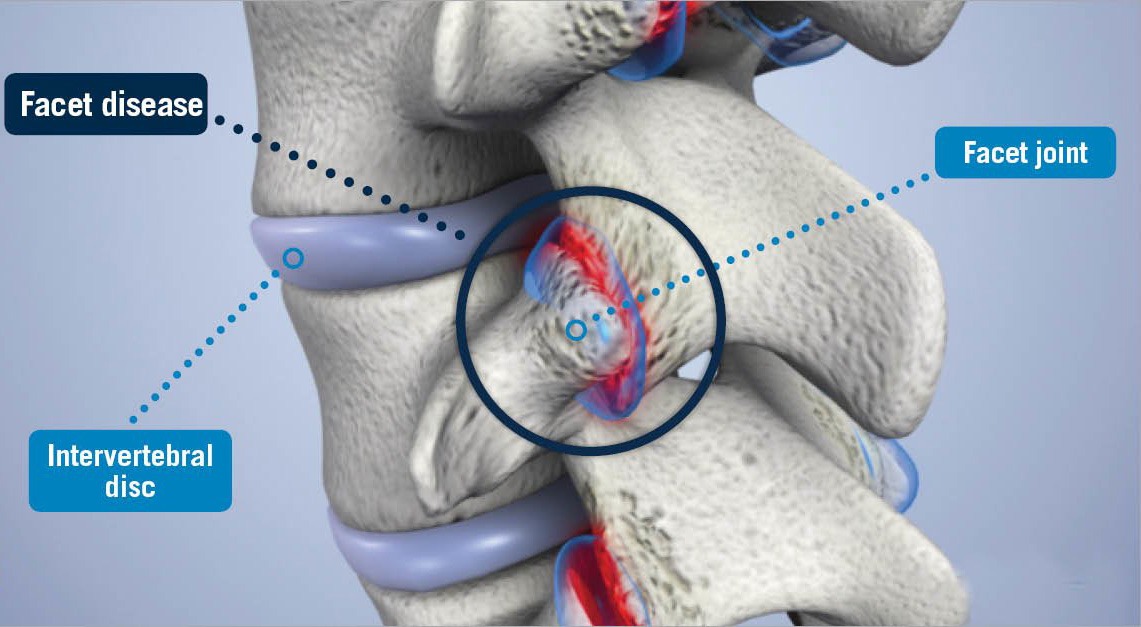- Conditions
- Procedures
- Patient care
- Why choose us
- Our Doctors
- Contact
Home » Spine Conditions »
Description of facet disease

Facet joints are the structures that connect the spinal vertebrae to each other. A facet joint is like many other joints in the body — it has a cartilage lining that allows the bones to glide smoothly over each other and is surrounded by a protective capsule. The function of a facet joint is to provide stability, mobility and support to the spine. Each vertebra has two facet joints, one on each side.
Diagnosing facet disease
Some of the terms commonly used in the diagnosis of facet problems include:
- Facet arthritis
- Facet joint syndrome
- Facet disease
- Facet hypertrophy
- Degenerative facet joints
These terms all refer to essentially the same thing — osteoarthritis or degeneration of a facet joint.
Causes of facet disease
Facet disease is caused by the cartilage in the joints being worn down as a result of wear, aging, injury or misuse. This type of injury to the spine can be attributed to arthritis of the spine, work, over-use or an accident. Facet disease occurs when a facet joint degenerates. While this can take place at any level of the spine, it most commonly affects the lumbar (lower spine) region. Another possible result of facet disease is spondylolisthesis, which occurs when a vertebra slips forward in relation to an adjacent vertebra, usually in the lumbar spine.
Symptoms of facet disease
Symptoms related to facet joint problems are usually localized to the area of the affected joint and are often experienced in the cervical (neck), thoracic (mid-back) and lumbar (lower back) regions. When facets in the lumbar region are affected, a patient may experience lower back pain that radiates to the buttocks and upper thigh area. If facets in the cervical area are affected, pain may occur in the back of the neck and radiate to the top of the shoulders or around the neck.
Conservative treatments for facet disease
Since there are many causes of neck and back pain, it is important to obtain a proper diagnosis. Facet disease diagnosis is relatively easy to accomplish with a thorough physical exam or a diagnostic facet injection (a numbing medication injected into the facet joint). If the source of the pain is the facet joint, then the pain should resolve immediately after the injection. If the pain persists after an injection, it may be caused by spinal stenosis or a herniated/bulging disc, which require different treatments.
Minimally invasive facet disease surgery
If an injection doesn’t effectively relieve the pain, the next step could be a laser facet thermal ablation, which is performed through a small tube (approximately the size of a quarter) and is a safer and effective alternative to traditional open neck or back surgery.^ The laser, fiber optics and irrigation apparatus are placed in the tube to facilitate surgery on the facet joint. Facet thermal ablation is normally performed in combination with a decompression procedure.
The board-certified surgeons+ at USA Spine Care will use a small incision to debride (clean) the joint and deaden the local joint nerve, similar to a root canal procedure performed by an endodontist on a tooth. Laser facet thermal ablation takes a short period of time to complete and can help resolve the pain associated with the facet joint. Contact our dedicated team with any questions or concerns you may have about our outpatient procedures.
USA Spine Care is the leader in minimally invasive spine surgery and has helped more than 75,000 patients find relief from chronic neck or back pain. To find out if you are a candidate for a laser facet thermal ablation procedure, reach out to USA Spine Care today. We can schedule a no-cost MRI review* to determine if our procedures would be effective in relieving your facet disease symptoms.
